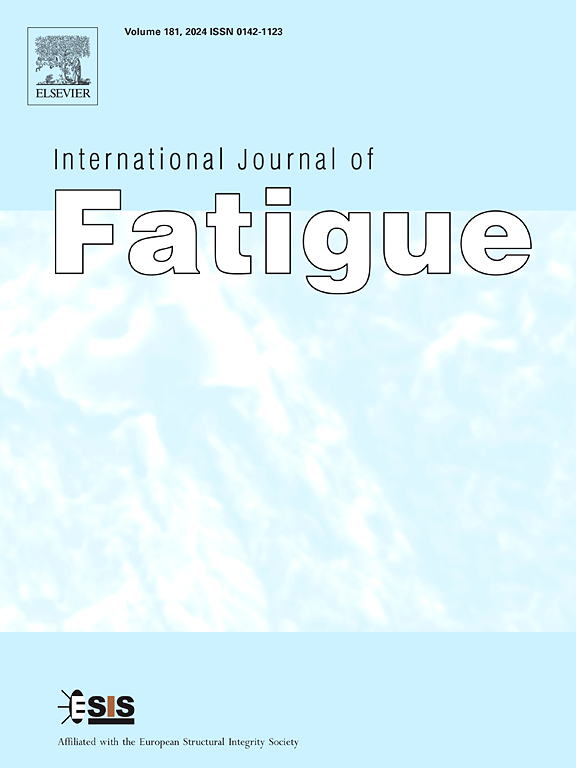Revealing anisotropic fatigue behavior and multiscale failure mechanisms of bio-inspired heterogeneous glass sponge lattice structures fabricated by laser powder bed fusion under high-cycle compression fatigue
IF 5.7
2区 材料科学
Q1 ENGINEERING, MECHANICAL
引用次数: 0
Abstract
Lattice structures (LSs) fabricated via additive manufacturing (AM) are widely used for their lightweight, high strength-to-weight ratio, and energy absorption properties. However, the long-term fatigue performance of metallic lattice structures (MLSs) remains challenging, primarily due to structural failure and manufacturing defects. This study investigates the dynamic compressive fatigue behavior of bio-inspired glass sponge lattice structures (GSLSs) and their variants. Combining micro-CT characterization reveals a structure–property relationship where nodal geometry optimization improves fabrication quality and fatigue performance. Results show that GSLS achieves the highest fatigue strength (0.7 = 17.897 kN) at 104 cycles, while GSLS-I exhibits the highest fatigue strength () at 10⁶ cycles (0.7 = 11.827 kN). Meanwhile, failure mode analysis shows that stress concentrations at nodes and horizontal overhangs accelerate crack initiation, explaining the more excellent fatigue stability of GSLS, GSLS-II, and GSLS-S (R2 = 0.99, 0.95, and 0.96) compared to GSLS-I and GSLS-III (R2 = 0.69 and 0.76). Finite element analysis (FEA) further elucidates fatigue failure mechanisms, confirming cyclic ratcheting and strut-level stress distribution as key factors influencing fracture. This study provides a predictive framework for fatigue failure in MLSs and offers insights into optimizing high-performance LSs for aerospace, automotive, biomedical implants, and other engineering applications.

高周压缩疲劳下激光粉末床熔接仿生非均质玻璃海绵晶格结构的各向异性疲劳行为及多尺度破坏机制
通过增材制造(AM)制造的点阵结构(LSs)以其轻量化、高强度重量比和能量吸收特性而得到广泛应用。然而,金属晶格结构(mls)的长期疲劳性能仍然具有挑战性,主要是由于结构失效和制造缺陷。本文研究了仿生玻璃海绵晶格结构及其变体的动态压缩疲劳行为。结合微ct表征揭示了结构-性能关系,其中节点几何优化提高了制造质量和疲劳性能。结果表明,GSLS在104次循环时达到最高的疲劳强度(0.7 Fmax = 17.897 kN),而GSLS- i在10 26次循环时达到最高的疲劳强度(Nf) (0.7 Fmax = 11.827 kN)。同时,破坏模式分析表明,节点和水平悬垂处应力集中加速裂纹萌生,这说明GSLS、GSLS- ii和GSLS- s的疲劳稳定性优于GSLS- i和GSLS- iii (R2 = 0.69和0.76)(R2 = 0.99、0.95和0.96)。有限元分析(FEA)进一步阐明了疲劳破坏机制,确认了循环棘轮和支柱水平应力分布是影响断裂的关键因素。该研究为mls的疲劳失效提供了预测框架,并为优化航空航天、汽车、生物医学植入物和其他工程应用的高性能LSs提供了见解。
本文章由计算机程序翻译,如有差异,请以英文原文为准。
求助全文
约1分钟内获得全文
求助全文
来源期刊

International Journal of Fatigue
工程技术-材料科学:综合
CiteScore
10.70
自引率
21.70%
发文量
619
审稿时长
58 days
期刊介绍:
Typical subjects discussed in International Journal of Fatigue address:
Novel fatigue testing and characterization methods (new kinds of fatigue tests, critical evaluation of existing methods, in situ measurement of fatigue degradation, non-contact field measurements)
Multiaxial fatigue and complex loading effects of materials and structures, exploring state-of-the-art concepts in degradation under cyclic loading
Fatigue in the very high cycle regime, including failure mode transitions from surface to subsurface, effects of surface treatment, processing, and loading conditions
Modeling (including degradation processes and related driving forces, multiscale/multi-resolution methods, computational hierarchical and concurrent methods for coupled component and material responses, novel methods for notch root analysis, fracture mechanics, damage mechanics, crack growth kinetics, life prediction and durability, and prediction of stochastic fatigue behavior reflecting microstructure and service conditions)
Models for early stages of fatigue crack formation and growth that explicitly consider microstructure and relevant materials science aspects
Understanding the influence or manufacturing and processing route on fatigue degradation, and embedding this understanding in more predictive schemes for mitigation and design against fatigue
Prognosis and damage state awareness (including sensors, monitoring, methodology, interactive control, accelerated methods, data interpretation)
Applications of technologies associated with fatigue and their implications for structural integrity and reliability. This includes issues related to design, operation and maintenance, i.e., life cycle engineering
Smart materials and structures that can sense and mitigate fatigue degradation
Fatigue of devices and structures at small scales, including effects of process route and surfaces/interfaces.
 求助内容:
求助内容: 应助结果提醒方式:
应助结果提醒方式:


